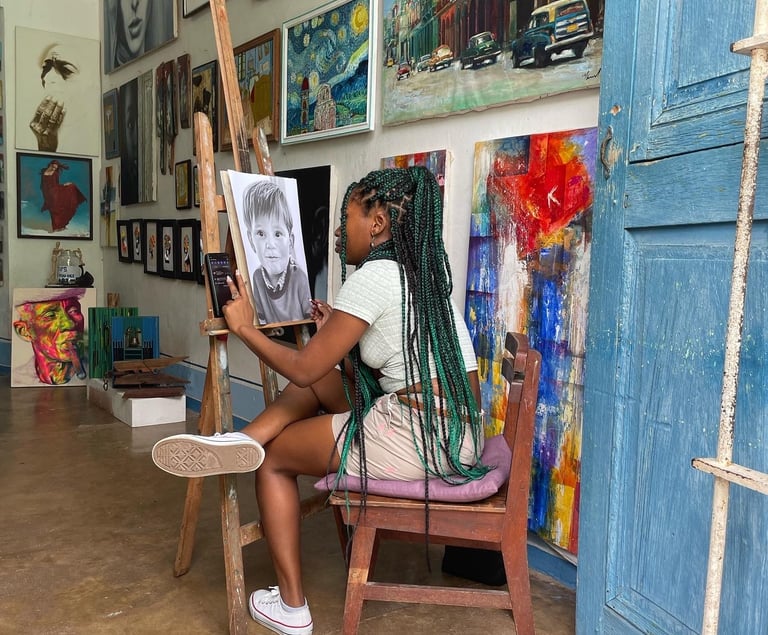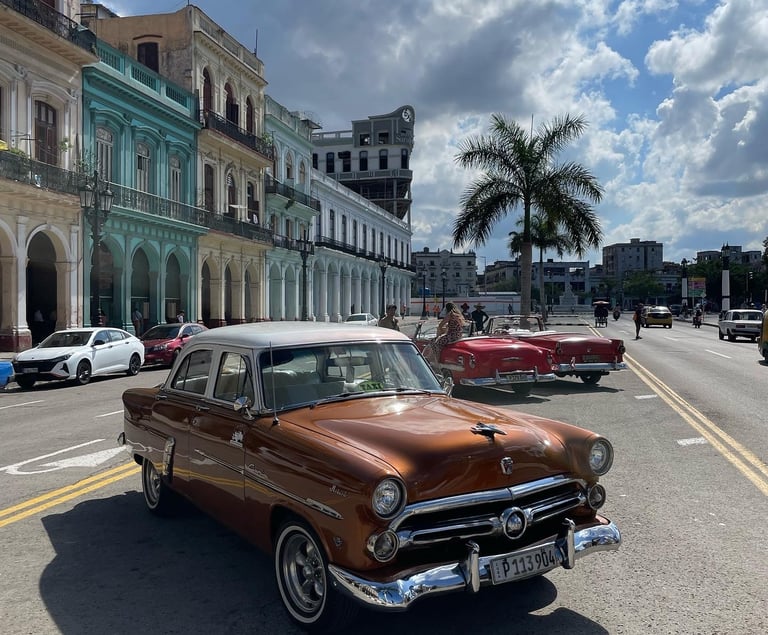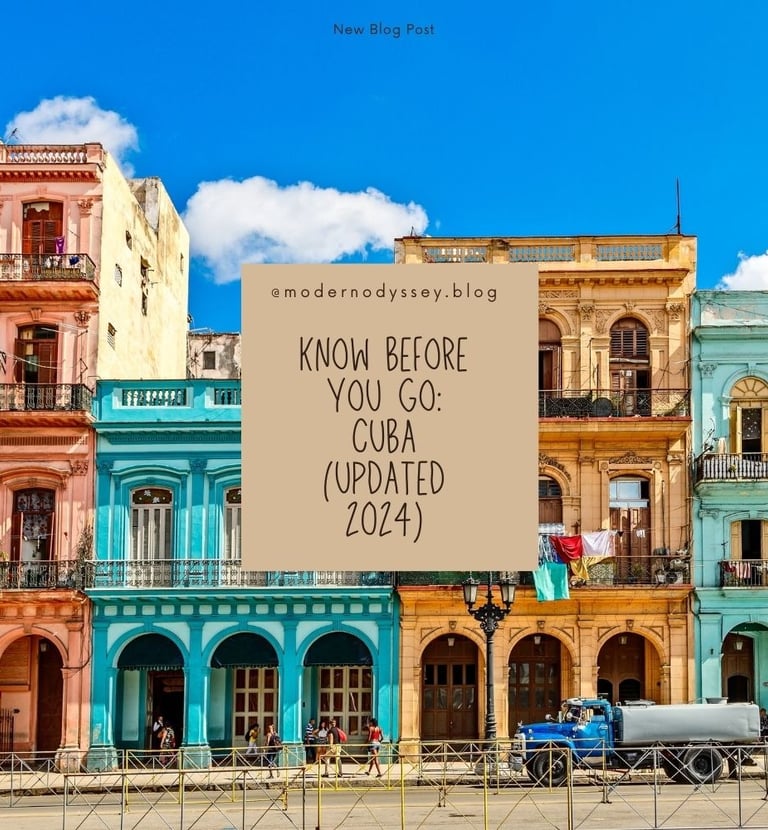2024 May
Know before you go: Cuba (updated 2024)
by Evi






You are planning your dream holiday in the biggest island of the Caribbean and you need some information before your trip? You are at the right place! We have travelled in November of 2023 and absolutely loved it! Cuba is the island of Che and Fidel, the island of ron (rum) and salsa, the island of contrasts. Here is a “know before you go” list:


How many days do you need in Cuba?
Cuba is a big island, a destination that can combine a beach holiday and a cultural trip. But if you want to see the highlights, 7 full days are more than enough. The main visit places should be Havana, Trinidad, Varadero and Viñales valley.
What is the best time of year to visit Cuba?
The climate on the largest Caribbean island is tropical and seasonally humid. There are only two distinct seasons, the wet and the dry, with local variations. The rainy season lasts from May to October. Therefore, the best time to visit Cuba for good weather is from November to April. This period offers pleasant conditions and warm temperatures averaging 26-30°C (78 - 86 °F), making it an incredible escape from winter. However, the peak tourist season falls between December and March, so plan ahead to secure accommodation and activities, as Cuba can get crowded during this time. We traveled to Cuba at the end of November.
What documents do you need to visit Cuba? How to obtain a Cuban visa?
If you hold a passport from any European country, rest assured that you'll need the ordinary Cuba Tourist Visa, to enter Cuba. If you're not from Europe, you might need a visa. Visa exemptions and entry regulations change from time to time so that some countries may be removed or added from this list, so please contact the Cuban Embassy or Consulate of your country.
For the issuance of Cuba Tourist Visa, you will need a passport, valid for at least 6 months from the date of entry. The airplane return ticket is also a requirement as well as a medical travel insurance for entering the country. The visa is single entry and is valid for a stay in Cuba up to 30 days, from the day of entry into the country. To apply for the visa, you need to contact the Cuban Embassy or Consulate of your country. As for Greece, the process is currently only available through travel agencies. The cost is 35.00€ and you need to provide them with a photocopy of your passport as well as your flight information. The Tourist Card visa is given to you physically and you must hold on to this small pink card for the entire duration of your stay as you must present it upon your departure.
By the time we visited Cuba in November 2023, our passports were not stamped either at the arrival or the departure, only our return ticket was stamped upon departure at the airport. During the process of the entry validation at the airport, be patient, the lines move slowly and the immigration employees just take their time! Welcome to Cuba and the laidback lifestyle!






Is it safe to travel to Cuba?
Cuba is in fact, a remarkably safe country for tourists. The country has the lowest crime rates in the Americas. Nevertheless, tourists are told to take normal travel precautions when visiting the island such as pick pocketing. We never felt unsafe during our trip. Even in Havana late at night.
How do you get to Cuba?
Cuba has 10 airports, but if you flying from Europe to Cuba you will probably arrive at the José Martí International Airport (HAV) which is located 20 kilometers (12mi) away from the center of Havana. There are many flights out of the most popular European hubs such as Paris (Air France), Amsterdam (KLM) and Istanbul (Turkish Airlines). Another airport serving international flights is Juan Gualberto Gomez Airport in Varadero (VRA) which is located 10km (6mi) away from Varadero.
How to get around in Cuba?
The cheapest way to get around in Cuba and commuting between cities is to use the public bus Viazul. There are at least a couple of buses each day between major cities. You can book your tickets in advance here https://www.viazul.wetransp.com/ For example, a ticket between Havana and Varadero costs 9.00€ each way. The bus ride is approximately 4 hours.
The other option is to use taxis for shorter rides. Everything that has 4 wheels in Cuba is potentially a taxi. Either it is a classic yellow taxi or a classic American car, you can raise your hand and negotiate the ride and the price. Always set the price before the ride.
How do I get from José Martí Airport to Havana?
To get from José Martí Airport to Havana, you can take a taxi, which will cost you around 30.00€ and the ride takes approximately 20-30 minutes. The other option is to take the public bus Viazul for 6.00€ each way. You can book your tickets in advance here https://www.viazul.wetransp.com/
How do I get from Juan Gualberto Gomez Airport to Varadero?
To get from José Juan Gualberto Gomez Airport to Varadero, you can take a taxi, which will cost you around 30.00€ and the ride takes approximately 20-30 minutes. The other option is to take the public bus Viazul for 6.00€ each way. You can book your tickets in advance here https://www.viazul.wetransp.com/
Can I rent a car in Cuba?
Although it’s possible to rent a car in Cuba to make it easier to get around, I don’t think this is really worth it. The car rental cost is significant high, ranging between 90.00€ to 120.00€ per day, due to limited available cars on the island. While the roads in Cuba may not always be in great condition, driving in the country is generally safe. To rent a car and drive in Cuba, you only need your valid international driving license and passport. However, you must be over 21 years of age car and held a license for at least 2 years. If you decide to rent a car though, it is recommended that you have a physical road map as signage can be lacking in many areas. It is better to make your reservation in advance through one of the official websites, such as https://www.havanautos.com/ At last, keep in mind that in order to fill the car with gas, you need to get to a gas station as locals do. The issue lining with that is that gas stations are limited in number and often run out of gas. You may find yourself waiting in line maybe for hours at a time.






What currency is used in and how to pay in Cuba?
The only national currency in Cuba is the Cuban Peso, also known as the CUP or simply the peso. It is officially the only currency accepted in Cuba for most transactions. Unlike other currencies that can be exchanged anywhere in the world, you can’t get Cuban pesos off the island, you’ll have to wait to exchange money until you arrive in Cuba. This means you should bring cash with you to Cuba.
As all currency exchange offices are government ones, the exchange rates are very low. You will see these offices at the Havana airport as well as in major cities and tourist destinations. The official exchange rate which regulated by the Cuban government was 1€ = 120 CUP in November 2023. This is also the exchange rate you will get if you withdraw CUP from an ATM.
Because the official exchange rate of the Cuban peso is regulated by the government, an informal exchange market is now well established in Cuba resulting to a much higher unofficial exchange rate. You will find informal money changers offering you exchange rates of around 1€=250+ CUP in November 2023. This has created a unique situation and an opportunity for locals, as they exchange the foreign currencies back to CUP from the government directly for an exchange rate of 1€=280 CUP. This margin in the exchange rate benefits both locals and tourists.
The best currency to bring to Cuba is Euro or USD. Most places do accept these foreign currencies but be aware of the exchange rate they offer you in advance. You can exchange money unofficially in restaurants and vendors, just ask them for the exchange rate.
There are only specific places you can use your credit cards as a payment method like liquor and cigar boutiques.
How to have internet in Cuba?
Internet has invaded Cuban society slowly in the last decade. Nowadays more hotels and casa particulares provide internet access although the connection is not always reliable. Some international mobile providers have a roaming agreement with Cuba, so you can use your home provider, but it might be really expensive. Currently, you can buy though a tourist sim card in Cuba, the Cubacel Tur card, in order to have access to the internet while you are on the move. You can pre order the card online in advance here https://suenacuba.com/tourist_sim_card_cuba_buy and collect it upon arrival at the Jose Marti Havana airport at the ETECSA stands, or just buy it on spot. The package for tourists currently is 6Gb of data, 100 SMS, 100 minutes and it is valid for 30 days for 35.00€.
Accommodation in Cuba
Cuba has two distinct types of accommodation options, hotels and casa particulares. Depending on your travel style, you can choose between government owned hotels situated in historic buildings in Havana to huge all inclusive beach resorts in Varadero or private accommodations in Cuban homes.
Hotels in Cuba
It’s important to keep in mind that the hotel star rating does not really translate the same in Cuba. As a result of the USA trade embargo, Cuba's ability to obtain construction materials, electronic parts, furniture etc. is really difficult. Hence, basic maintenance of the buildings and the facilities of many hotels is very challenging. Therefore, you might find yourself in a huge all-inclusive resort in Varadero where your room will be just painted in order to mask the humidity stains, or half of your rooms door frame will be missing. Another thing to keep in mind is that basic products like toilet paper or cleaning products may be in shortage at some point. So take it easy, relax and embrace the differences as a cultural characteristic. Food in hotels might also be an issue as there is a shortage of products from time to time and you might not get your steak every day. Rest assured though that you will not stay hungry as Cubans are pretty resourceful and you might find yourself served with a big lobster for dinner. Although, large hotel management chains are investing in the island, they are not given the necessary freedom to reform the tourist infrastructure in order to be able to offer a high quality tourist product.
Casa Partculares in Cuba
A casa particular is a type of accommodation in Cuba that is similar to a guesthouse or an airbnb as we tend to call them these days. You can easily recognize them by the white sign with the blue logo outside. A casa particular usually offers accommodation in a one bedroom apartment with toilet. The hosts may offer breakfast and dinner with an extra charge. Staying in a casa particular is the most efficient way to get to know the Cuban culture and connect with locals. The same rules regarding the shortage of materials and products apply here, therefore do not expect luxury accommodations but rather simple and basic ones. By choosing to stay in a casa particular, you support the Cuban people and the local community.
Cuban Cigars
If you are a cigar lover, then Cuba is your paradise on earth. There are many official stores (government owned) that sell all Cuban cigar brands in their official prices. One of them is La Casa del Ron y del Tabaco Cubano in Havana where you will find authentic cigars in official rates, and what I mean by official rates, well the same prices that you will find them sold in Europe. The variety is by far the largest you will ever find and there is a bar that you can enjoy your cigar accompanied by the ron of your choice. On the other hand, if you want to buy cigars in better prices your only other options is from a tobacco farm in Vinales. The prices there range from 3.00€ to 10.00€ depending on the size. Of course you will encounter many people on the streets eager to sell you “authentic” cigars in extremely low price. Don’t fall for this trap as in most cases the cigars contain other leaves in addition to tobacco like nettle.






Cuba - Know Before You Go - Updated 2024
Cuba - Know Before You Go. What you should know before you travel to Cuba in 2024. You are planning your dream holiday in the biggest island of the Caribbean and you need some information before your trip? You are at the right place!
